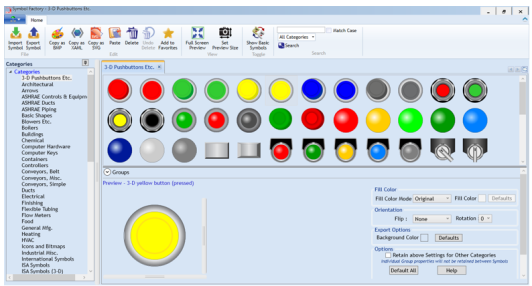Picture/Graphic Object for Canvas 
Note: For Canvas Series only. For all other controllers, seePicture/Graphic Object .
See also: User Interface
See also: Graphic Object Toolbox for Canvas Series
Topic Menu
Overview of the Image Object
Displays single image [bitmap]. From Cscape 9.90 onwards, dialog for selecting images [bitmaps] have been improved. Image preview and more info on images selected have been added. The last used directory for selecting images is retained the next time the dialog is opened.
The Image Object can be accessed through the Screens Project Toolbox > Fixed Objects > Picture/Graphic. Select the Image object and drag to a new screen. This object can be placed anywhere on the screen. User must be on a Screen and not in the Main work area in order to see the Objects Project Toolbox items.
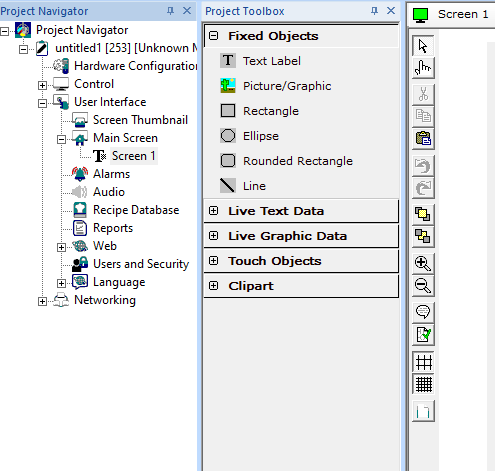
Image Object Configuration
Selecting the Image object, displays the following Image Properties window:

Preview - Displays the preview of the selected image with edited configuration.
Select Image >>> - Displays the following windows Open dialog for user to select the image from local drive. Following image types are allowed - .bmp, .png, .jpg, .jpeg and .svg.
Note: The last used directory for selecting bitmaps is retained the next time the dialog is opened.
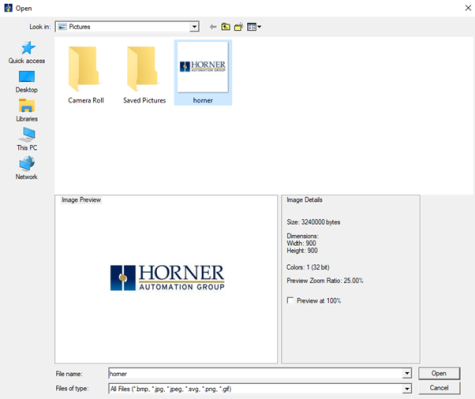
Edit Image>>> - Opens the local paint program.
Note: The Tools/Set Bmp Editor must be configured to the file location of a bitmap (bmp) editor. Generally this is MS Paint which is supplied as part of the Windows or NT operating system.
Select Symbol>>> - Opens the Symbol Factory. Symbols can be selected the Symbol Factory.
Note:
Transparency

-
Treat Background as Transparent - In Bitmap properties window, select Treat Background As Transparent option and select the color which needs to appear transparent from Transparency Color >>> option. Selecting Transparency Color >>> option displays The Color Picker window from which user can select the color which needs to appear transparent.
-
Treat similar colors as Transparent - This option allows Cscape to automatically convert pixels in images that have transparencies to almost match the transparency color.
-
Sensitivity - By selecting the sensitivity range (i.e., by moving the slider to required position), the transparency color density will be reduced.
Scale to Fit - Resizes imported image to match bounds of object. If not selected, the object’s lower-right bounds are recalculated to match the image’s dimensions. If the image is larger than the screen, then it is clipped appropriately.
Tile - Selecting this option displays imported images in one or more repetition of same image. The number of repetitions depends on the size of the object.
Maintain aspect ratio - Selecting this option resizes the imported images to the size of object maintaining aspect Ratio.
Maintain aspect ratio with clipping – Selecting this option resizes the imported images to the size of object maintaining aspect Ratio with clipping.
The Color Picker

Selecting More >>> displays the following window allowing user to select color apart from default colors available in the above displayed color picker window.
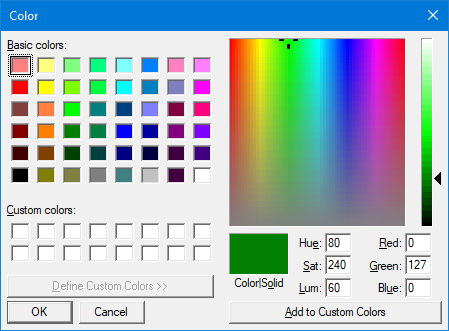
Note: Both "JPEG Compress" and "Treat Background As Transparent" options cannot be selected for an object.
Attributes >>>

Static
Visible
-
Non-touch units* - all objects are always visible, so as a result both the static and dynamic override fields will be grayed out.
-
Touch units** - the visibility attribute may be set as static or dynamic.
-
*Non-touch units include X2, XLE, and XLEe.
**Touch Units include all XL series, Prime Series, and Micro OCS series controllers.
-
When the attribute is statically set to ON, the object is always visible and always responds to touch signals.
-
When the attribute is statically set invisible (unchecked) the object is not drawn but if the object is the front most object it responds to touch signals. For example, placing a statically invisible screen jump object in front of a bitmap allows the bitmap to be drawn but touching the location of the invisible screen jump causes the screen jump action to be performed.
-
When this attribute is dynamically enabled the visibility of the object is controlled by the associated bit in the override register. When the bit is ON the object is drawn and operates normally. When the bit is OFF the object is not drawn and does respond to any touch signals.
Dynamic
Override variable – This register / variable is used to control the dynamic properties like visible, Flash, Enable Input and Colors.
Enhanced - Selecting Enhanced button displays the following window:
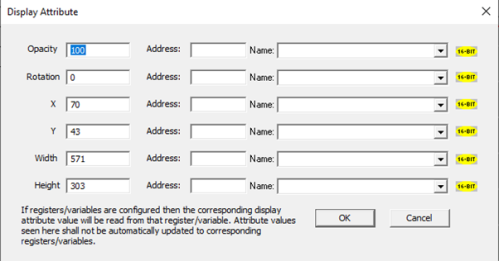
This option is used for configuring the different display attribute of graphic objects mentioned below. The following options can be configured either using constant values or via register / variable.
-
Opacity – User can configure the display opacity of graphic object. Range is 0 to 100.
-
Rotation – User can configure at what degree the object should appear rotated. Range is -180 to 180.
-
X and Y axis – User can configure at what X and Y axis the object should be placed on the screen. Range depends on the model selected.
Width and Height – User can configure at what width and height the object should be displayed on the screen. Range depends on the model selected.
